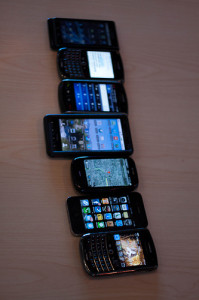An in-depth look at how a switch can be used to control an iPad.
See also
- Setting Up Switch Access to an iPad via CALL Scotland
Personal information for/about people on the autistic spectrum
Details of how to complete different tasks or how to obtain relevant materials
An in-depth look at how a switch can be used to control an iPad.
See also

One of the intentions of the Autism Card project is to look at cost-effective technologies. Although much of what we’re investigating revolves around devices that can be substantially cheaper than existing assistive devices, ‘cheap’ could in practice still mean hundreds of pounds either one-off costs for buying a device or for a rolling mobile phone contract, for some this will still be prohibitively expensive, especially if you are an out-of-work adult.
“only 15% of adults with autism are in full-time paid employment.”
– The way we are: autism in 2012 [PDF], National Autistic Society
Are there cheaper ways of getting some of the same benefits of the more expensive devices?
eReader devices are specialised devices helping you to read electronic content. They are often cheaper than tablets but are more restricted in what they can do. As they are generally simpler to use and have fewer options to choose from, these ‘restrictions’ may be helpful if you get easily confused trying to make a choice. The cheaper devices will also usually be greyscale (black and white) rather than colour and some don’t have sound but they are usually much more tailored to reading text easily than an average tablet. Because they tend to use less power you can normally go longer between needing to recharge the device than a tablet. Examples
eReaders do usually have touchscreens and WiFi, WiFi enables a device to wirelessly connect to the internet and from there you can download content directly to the device via online ‘stores’ (there may be charges depending on the kind of content). The range of content available will depend on the store. Some eReaders offer apps allowing you to browse the web and read web pages. And when you have an eReader you can read eBooks, there are ways of getting free eBooks including
The pace of change in hardware the technology sector is ferocious. Those who can afford to buy the newest devices might be selling or getting rid of their older devices every year or two, especially with phones. You might want to keep an eye on online auction sites like eBay for sales of cheaper used equipment or budget new devices.
Particularly in the Tablet category you’ll find lots of new but unbranded devices or brands you’ve never heard of – normally manufactured in the far east and imported to the UK. Maybe a good analogy is running shoes: you could buy labelled brands with a certain reputation ‘Nike’, ‘Reebok’ (like Apple/Samsung)…or you could buy ‘trainers’ with no big name brand, usually cheaper and maybe not the same build quality but they can still serve a purpose and be more affordable. In technology where cheaper unbranded devices might be more restrictive is in things like resolution of screen (seeing sharp pictures), and storage capacity (how much content you can store) and generally less robust (cheaper connectors/materials more likely to break/scratch) so take good care of these devices and invest in strong cases to avoid damage.

Lots of buildings/venues offer free WiFi these days so keep your eyes peeled and look out for the WiFi logo.
A simple way to find places that have free wifi is simply to go to Google and search for your town name along with the phrase “free wifi” e.g.
Aberdeen “free wifi”
Watch out! If you are out and about and have a phone that allows you to download apps try and make sure you do wireless downloads using a WiFi connection rather than 3G/4G in your phone. Apps can be several megabytes in size – particularly those containing video, on a 3G connection you may get a bigger phone bill or use up your phone data quota too quickly. So if you don’t have WiFi in your house, seek out a WiFi hotspot to save money.
A local library may offer access to WiFi in their buildings to registered members e.g.
Library staff are also usually very helpful if you need a bit of training getting started using IT, some places will even offer free courses.
Buses: Companies such as Stagecoach and Firstbus have WiFi available on some routes
Trains:
Some places you might need to get a particular password to use a venue’s connection so don’t be afraid to ask. You might find WiFi hotspots in commercial venues like cafes, fast food outlets and shops. Commercial places are more likely to ask for some personal information like a mobile phone number, so check the fine print on their terms and conditions or you might end up on their mailing lists.
If you are attending a college or university there may be particular places on the campus where you can get a WiFi connection perhaps using an account at your institution or using a service called ‘eduroam’ – see eduroam: participating organisations.
If you have a broadband internet connection at home and your modem/router has been installed recently you might already have WiFi available or may be able to upgrade for a small charge but you might need a bit of setting up to use it the first time and to set a password for your own WiFi network. Having WiFi at home will make it cheaper to use your mobile device and easier to keep your device and data up to date.
Larger companies can offer access to hotspots elsewhere outside your house. Examples

Most smartphones/tablets have a way of locking the screen so that access to your device is protected by e.g. a password, pin number/code, gesture, face and fingerprint recognition,… new methods are coming along all the time. The lock will usually start when you haven’t used your device for a few minutes – sometimes you can choose what length of time this should be – shorter is more secure. Locking is strongly recommended, especially if you are storing sensitive personal data on your device or traveling. Locking will prevent others from just picking up your unattended phone and using it without your knowledge. Be careful though that you choose a method of locking that you’ll be able to remember how to use or you’ll lock yourself out of your own device! If you’re clumsy, locking also helps stop you unintentionally press buttons or launching apps e.g. when the device is in a pocket or bag, helps prevent you making accidental phone calls or draining your battery.
Hand-held devices though easy to carry can also be easy to lose, small thin devices may slip through a gap without you noticing, you might leave a device behind on public transport etc. (Tip: if you’ve lost your device try contacting their ‘lost property’ departments, you’ll find the details on your travel company website). If you own a device have a think about who/where should be contacted if someone who doesn’t know you comes across your device, if it’s your mobile phone you obviously can’t use your mobile number as a contact. So how could a well-intentioned person contact you? You might want to physically write a contact phone number on a label stuck to the back of a device – but don’t put too much personal info here as you don’t know who will be reading it. Electronically, some lock screens allow you to type some text to be shown even when someone is prevented from using any of the features of the device.
At the moment iPhone/iPod/iPad don’t have customised lock screen text built in but what some people do is to create a customised wallpaper containing contact details and use that on their lock screen
Apple has some additional advice
If you are part of an organisation owning multiple devices it’s also a sensible idea to add security tags with a unique number or code to your devices and keep an internal register of codes and a note of who has been issued a device and/or where it might be found. You can find security labels where you buy business labels or stationery (might be called ‘asset tags’ or ‘permanent labels’, more expensive versions for security purposes can be tamper-proof). Labels are also very useful for any auditing/insurance purposes so you know exactly which device is which.
Reminder that most Scottish libraries have agreements in place to lend digital versions of books. A great source of free content for learning and relaxation, reading on your computer or handheld device.
For full details visit
eBooks from public libraries via CALL Scotland Blog.
In reading some of the research studies involving adults on the autistic spectrum, one of the more valuable functions an assistive device can have is to remind the person of upcoming events or the next step to take when tackling a sequence of tasks. Autism can make it harder for individuals to adjust to changes of routine so anything that will provide a pointer to what comes next could be useful. There can be times where people have poor memory and forget that they have important appointments to keep, or you become so engrossed in one particular task that you need some kind of “nudge” as a reminder to move to the next task. It’s no exaggeration to say that there are literally thousands of apps available for smartphones that can assist with time and task management – it’s a very highly utilised category of app for all people.
Most mobile phones, even the most basic kind, have some kind of a clock feature built-in. And where you find a electronic clock you will often find means of settings alarms for alerts at particular times. You can usually choose what sound or ring tone should be used when the alarm goes off, on some devices you can even choose to play a music track on your device. Also useful is a countdown timer – say you have a particular task that is supposed to be carried out within a certain amount of time, then set a countdown alarm and an alarm will go off after that particular amount of time has passed.
On Android the clock app may vary by who manufactured your device, you may have an analogue clock face or a digital clock display and often the choice of which kind you prefer. A clock is usually displayed on your home page on your device (the screen you see when you first start it up). On some devices you can set alarms via tapping on the clock.
Similar to clocks for time, devices will usually have at least a basic calendar feature to show the date and days of the month. On smartphones calendar apps become particularly powerful when you are able to add your own events to their calendar for reference and optionally receive notifications and reminders. This can be an excellent way of planning for the future by making sure you don’t miss something important.
In the calendar entry for the event itself there may be space to enter names/addresses/photos, anything of relevance to that event or venue. For visual learners you may wish to add photos of people you are due to meet or buildings you have to visit. For events taking place at a different location you could include transportation/journey details in advance so that you don’t have to figure that out on the day when you may be more stressed. For events in the calendar you can add alerts that pop up something visual on your phone to remind you and/or play some sound.
Details of how to use the Calendar app on iOS devices can be found in your “User Guide” document – downloadable from the Support:Manuals section of the Apple website.
See also

When you buy an electronic device like a mobile phone these days you’ll probably find that it comes in a small box with very little paperwork inside. Usually you’ll find some kind of “getting started” or “quick start” leaflet with the bare bones of how to start using your device along with any safety or legal notices. What a lot of people don’t realise is that most manufacturers also produce user manuals for using the devices. For economic and ecological reasons they don’t often ship printed manuals these days so it’s likely that they’ll tell you to visit their website to download any other information relating to their device.
Would always recommend that you have a read of any user manual at least once, sometimes you don’t always know all the features and things your device is capable of! Even if you don’t have a use for these features right away, just knowing what you might be able to do in the future is helpful especially if your own health changes. If your device has accessibility features it will normally be outlined in the manual so this can be useful to you or a carer or professional to help set up your device in such a way that it’s easier for you to use.
Tip: phone manufacturers tend to put downloadable manuals (usually PDF files) in a section of their websites called ‘Support’, some may have a product page on their website for your device and then have links to other documents there. It usually helps if you know exactly what model of device you have, it may be a name or some seemingly cryptic combination of letters and numbers. Here are some places you might find the model
Here’s a list of support sections for some of the main manufacturers. If you haven’t read yours…
Stop What You’re Doing Right Now And Go And Read Your User Manual Instead!
This is a worked example to try and find an example of an approach that might help with existing problems giving a destination on Glasgow buses for those with travel cards (see Pros and cons of autism alert cards and travel cards for details).
In computing we normally call text that’s to be displayed in large lettering a ‘banner’.
So I did a search on the word ‘banner’ on the Google Play App store. And though not all match our intended use there are some that would seem to do what we want. Now if you’ve never downloaded an app from an App store what you very commonly find is that apps for free may have some advertising within them that may or may not be a barrier in what you want to do, mostly but not always paid apps don’t usually have adverts and will often have a larger range of things the app can do – we call these ‘features’.
N.B. If you have photo-sensitive epilepsy be very careful if you try these banner apps out. Most of them will, as a demo, scroll text quickly, some will flash or blink.
I was specifically looking for an app that might provide a banner of large text in clear type that could be read from a distance and in low-light conditions. This could mean that your phone/tablet could be held up to e.g. the bus driver to show what destination you want. Because place names can be long and won’t always all fit on the screen the text needs to be able to animate or scroll so the entire name can be shown. To get the maximum amount of width for text it helps if you turn the device on it’s side with the longer edge at the bottom, shorter on the sides i.e. ‘landscape mode’.
The following sample can display text or can speak short phrases. N.B. There are literally thousands of apps in the app store, I’m only using this as a worked example.
This particular app is free but be aware there is a little bit of advertising. This app allows for up to 15 phrases to be stored and reused though you can change them at any time. You very simply tap on one of the rows of text and type in what text phrase you want to use. In the settings for the app you can change the size of the text, scroll speed and background and foreground text colours, I’ve chosen a blue background and white text in my demo.
You tap on the letters ABC in the middle of the screen to indicate you want to display a banner in solid lettering.
To display a banner, tap on the letters ABC in the square to the left of the text phrase you want. Screenshot shows a part near the beginning of “Sauchiehall Street”. The text fills the entire width of the screen and then scrolls the phrase continuously until you tap the screen again.
You tap on the picture of the loudspeaker to indicate that you want to use text to speech. Then you tap on one of the rows of text and type in what you want spoken. When you are ready to have the device speak on your behalf just press the loudspeaker next to whatever phrase you want to speak.
If you were using the same destinations repeatedly then using the app would be quicker as the text would already be entered so you would only have to tap the square ABC. This app will use the voice you have selected in your accessibility settings (see How to…Scottish voices for text to speech on Android for more details)
I’ve recorded sound output via the Scroller – LED & Voice using CereProc Scottish voice ‘Heather’. I’ve just tapped through a list of names:
Download the CereProc Scottish placenames [MP3]
Searching for synthetic voices for reading out text via Text-To-Speech (TTS) or speech synthesis systems found a Scottish company called CereProc. For a number of years they have been providing voices for desktop computers and now they have released versions that work on the Android platform for tablets and some of the newer and higher specifications of smartphones. This technology has come on in leaps and bounds in recent years and although not perfect and pronunciation may be a bit off for some words, it’s certainly improving over time and may be an option for anyone wishing to have a device speak on your behalf.
There are some limitations like the hardware volume of the device will limit how loud the spoken sound may be which might not be loud enough in busy environments.
I’ve recorded examples of the synthetic speech that can be used on Android see the demo at the end of this post.
Tech note: In my tests I’m using a Google Nexus 7 tablet which you can currently buy for around £200.
N.B. The way the Glasgow voice is presented on the Play store it seems to be intended as a “jokey” example. This is a pity and don’t let that put you off as it does do an surprisingly good job of pronouncing in the Glasgow Scots dialect. In our example of Pros and cons of autism alert cards and travel cards one point raised was
“…With synthetic speech it’s important that the ‘voice’ shouldn’t lead to the person being ridiculed in public…”
Maybe more middle-class people might find the Idyacy Dodo Glasgow voice humorous but if you come from a more working-class area of Glasgow using some of the ‘posher’ Scottish voices like Stuart might make you the odd one out and possibly lead to mockery. So a lot depends on who you are surrounded by and the situation. Having the ability to switch between formal/informal voices easily could be an advantage in e.g. the workplace or interview situations vs. at home.
On Android there is a device-wide “TalkBack” option which is really intended for blind or low vision users – this will help navigate the device by reading out app names or notifications etc. However, Android doesn’t quite seem to be at the point where any text within any app can be dictated, it depends on whether the app developers have added support for it. So to really make use of installed voices you need to look for apps that support text to speech.
Audio recording from the output of the tablet device speaking some sample text using CereProc Scottish Voices for Android [MP3].
See also How to…show a banner of text or speak short phrases using Android (bus journey example)